4. Sales in the Facebook Era
“Sales IS social networking!”
—Geoffrey Moore, author, Crossing the Chasm
As anyone who has ever bought or sold something knows, selling is an intrinsically social activity based on mutual trust. Even in the case of commodity products and services, relationships can sometimes even trump price as the deciding factor in purchase decisions. Ultimately, people enjoy doing business with people they like and refuse to do business with people they don’t trust.
A major result of the democratization of business described in earlier chapters has been unprecedented market competition. In today’s business landscape, companies are faced with a greater number of competitors and savvier buyers empowered with information. More than ever, sales reps must take the longer-term view of their customer relationships instead of trying to maximize the value of a single transaction. With fewer unfair structural advantages for reps to count on, timely insights into customer needs and interpersonal communications in the sales process have become requirements for closing the deal. Online social networks are emerging as critical business tools to help facilitate these insights and communications.
In the first edition of this book, I described how the social Web changes each step of the sales cycle and how CRM systems should be updated to incorporate the new technology. Many of you contacted me on Facebook and at conferences, saying, “We don’t just want to learn how to use Facebook—we want tools to do this!” Well, thank you for giving me the inspiration. I quit my day job at Salesforce.com and started a software company to build truly social CRM. My company, Hearsay Labs, provides social relationship management for companies to manage, socialize, and personalize customer interactions across Facebook, Twitter, and the social Web (see Figure 4.1).
A lot of the new depth and rich examples from this edition come directly from the tremendous learning and innovation we have developed with our customers in the last year. It’s very exciting. We are breaking new territory with how people buy, sell, share, and make decisions in the Facebook Era. I know many of you out there are, too.
Figure 4.1
Hearsay 360 is a social CRM application. Inspired by feedback from the first edition, I started Hearsay Labs to help companies harness the social Web to reach new audiences, build better customer relationships, and achieve viral business growth.
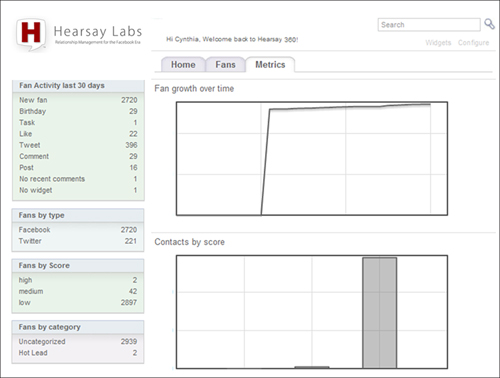
This chapter walks through a typical sales cycle and discusses where it makes sense to leverage social networks to increase sales effectiveness. The chapter concludes with a short discussion on the implications for CRM and how the future of information contained in CRM will likely be bidirectional between companies and their customers. Chapter 10, “How To: Build and Manage Relationships on the Social Web,” provides concrete instructions on how individuals can build and manage relationships on Facebook for sales or other activities.
Transforming the Sales Cycle
Sales reps can use online social networking to become more productive in two ways: to glean insights about customers and to engage in casual communications with customers. From the customer’s perspective, the sales call has the potential to become more personalized and relevant. It’s no longer acceptable for reps to generically push every product and service. Today’s reps are expected to have “done their homework” based on the information available on the Internet and on social networking sites. Customers, for their part, are responsible for managing and maintaining what information they choose to share with whom. Chapter 10 explains how to use Facebook privacy controls to manage online identities, and Chapter 15, “Corporate Governance, Strategy, and Implementation,” speaks to more general issues and concerns about privacy and security.
Based on the sales deals I’ve been on, as well as interviews with other colleagues in sales, I have identified eight aspects of the sales cycle that stand to benefit from the online social graph: establishing credibility, prospecting, making the first call, navigating complex customer organizations, collaborating across sales teams, providing customer references, building and sustaining rapport, and ensuring ongoing customer success with post-sales support. These are also very much in line with the general techniques advocated by popular sales methodologies such as Miller–Heiman and Customer-Centric Selling. I describe the first seven in this chapter and devote the entire next chapter to customer service and support.
Before we delve into the sales cycle, let’s call out some differences between B2B (business-to-business) and B2C (business-to-consumer) sales and discuss how these might affect social sales strategy.
B2B Versus B2C Sales
Selling to consumers, or business-to-consumer (B2C) sales, tends to be more straightforward, transactional, and driven by product and marketing. Because of a lower price point and fewer people involved in making the purchase decision, B2C typically has a shorter sales cycle. For many items, especially those less than $100, it is usually more about marketing than about sales. Often no salesperson is involved. From an online social networking perspective, these goods and services can benefit from social merchandising, targeted advertising, and viral marketing tactics, which we discuss in Chapter 6, “Marketing in the Facebook Era.”
As we go up in price and complexity, B2C begins to resemble business-to-business (B2B) sales. Especially when “intangibles” such as warranties, customer support, authenticity, and service quality factor into a sale, trust and relationships become critical differentiators (see Figure 4.2). B2B selling into organizations is often a multistep process involving multiple stakeholders and levels of decision making, resulting in a longer sales cycle. The upcoming sections on collaborating within a sales team and navigating customer organizations are directed especially at B2B sales. Finally, B2B deals tend to be custom transactions. These typically involve negotiation because of a higher markup and imprecise information about the value of the good or service being offered.
Credit: Timothy Chou, cofounder of Openwater Networks and lecturer at Stanford. He whiteboarded a similar concept for me in his office in June 2008.
Figure 4.2
Relationships and trust play a bigger role in purchase decisions of higher-priced items that are more difficult to value and require greater expertise to understand.
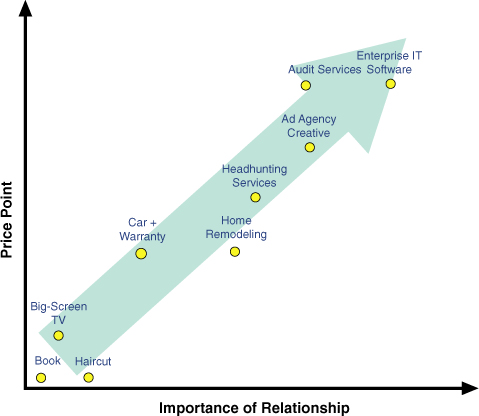
But why use a person-to-person tool such as Facebook for selling to an organization? The important point to keep in mind is that individuals are at the heart of any organization. Individual people, not entire companies, make purchase decisions. Transactions succeed or fail because of a few key individuals—your customer champion, executive decision maker, customer reference, sales rep, and product expert. By strengthening the bond and improving information flow among your internal deal team and with key customer stakeholders, social networking sites can help your company create a more productive selling machine.
In the following guest expert sidebar, veteran sales account executive Chris Cranis provides specific tips on how companies can use Facebook for B2B sales. Cranis has been a top sales rep at a number of B2B companies, including Ribbit (acquired by British Telecom) and Salesforce.com.
Five Tips for How Sales Reps Should Use Facebook
Chris Cranis
“The most valuable commodity I know of is information, pal.” —Gordon Gekko, Wall Street (1987)
The number one reason a sales rep should use Facebook for finding business is research. Sales reps can leverage this research in five ways:
1. Research your prospect’s company—No better tool on the Web gives you as much insight into a prospect or customer. Facebook provides a global hub of information that you can use to understand the people you want to sell to. The information you gather is priceless when you talk to your prospect. The more you understand their business, the more your prospect will trust you and the ideas you are pitching.
2. Research your prospect company’s Groups and Facebook Business Pages—Start by searching for Facebook Groups and Pages related to your prospect. If you are lucky enough to find one, join the Group or “like” the Page immediately. Scan the list of fans and read the wall posts, including recent announcements. Has the company posted anything recently that aligns with your product?
3. Research your prospect’s people—After you “like” a Page, spend some time focused on other people who have also “liked” the Page. Many times you will notice that they are employees, ex-employees, vendors, partners, and the like. Knowing who else “likes” a Facebook Page is a great place to understand the marketing goals of your prospect or customer.
4. Research your prospect’s links—When you join a company Page, often other members will post specific links redirecting you to other Web sites that provide incredible information for you to digest and understand their strategy. Visit each page and ask yourself a few questions, such as, “Why is this site important?”“How does this impact the overall business strategy or plan this company has set forth?”
5. Research your prospect’s ideas—Facebook Pages provide you with amazing visibility into what your prospect’s customers are saying and suggesting. Figure out what your prospect’s customers are asking of your prospect and include that in your sales pitch.
Chris Cranis (@forceIUS) is a senior account executive at Salesforce.com.
Now let’s walk through a typical sales cycle and talk about how the social Web changes each stage.
1. Establishing Credibility
First, sales reps need to establish credibility that they are competent and committed to delivering customer success. Traditionally, reps had to rely on the brand reputation of their company and products, and their Rolodex of customer relationships slowly built up over many years.
Following the personal branding discussion in Chapter 2, “The New Social Norms,” sales reps and others today can accelerate the process of building trust by using social networking sites to convey qualifications. For example, a typical LinkedIn profile contains four types of information that would have been awkward or more difficult to provide in the past: public testimonials, list of connections, professional experience, and education pedigree. Similar to Amazon.com’s customer reviews on books and Zagat’s customer reviews on restaurants, social networking sites are becoming the de facto place for reviews on business professionals. If you have satisfied customers, it might not be a bad idea to ask them for public testimonials on LinkedIn or the Testimonials application on Facebook. Chapter 8, “Recruiting in the Facebook Era,” goes into greater detail about LinkedIn recommendations in the context of job candidate references.
Bidirectional visibility helps foster mutual trust. With this information on hand (which you have chosen to share), prospective customers are empowered to “check you out” as a sales rep and hopefully gain confidence in your knowledge and competence in helping them find the right solution for their needs.
2. Prospecting
As we cover in the next chapter, marketing is responsible for generating leads en masse. But great salespeople are able to source their own leads, too. As Tupperware party hosts and Mary Kay beauty consultants have known for decades, sometimes your best prospective customers are right in front of you: friends, family, and acquaintances.
However, most people wouldn’t feel entirely comfortable calling the list of contacts in their phone book. Fortunately, as we talked about in the previous chapter, online social networks have created a new set of interaction modes and relationship types, such as Facebook friends and LinkedIn connections, that make it less invasive, more comfortable, and easier to ask favors of your network.
Before social networking sites, it was both less efficient and less socially acceptable for sales reps to directly prospect into their networks. It was inefficient because they had no easy way to tell who among their contacts might be interested in their product. It was invasive because sales reps burned through social capital each time they tried selling to someone who was not interested.
In the Facebook Era, it is a different story. LinkedIn and Facebook (and Twitter, to a lesser extent) generally have employment information (location, employer, and role) for each contact. The sales rep can search on the exact profile of the ideal target prospect and qualify the lead earlier in the cycle. The sales call feels less invasive because the interaction feels more casual, and the pitch is targeted specifically to the prospective customer’s profile. The following case study profiles how one company, Aster Data Systems, successfully sourced its initial wave of customers using social networking sites.
Social Graph Prospecting at Aster Data Systems
Aster Data Systems, a start-up software company located in Silicon Valley, has dramatically grown its business through creative use of LinkedIn. As a small start-up, Aster lacked brand recognition and did not have the budget for large marketing or advertising campaigns.
To source early customers, Aster instead tapped into the company’s collective social network on LinkedIn, MySpace, and Facebook. Senior management asked all employees, not just sales reps, to tap their networks for potential prospects who had keywords such as “data warehousing” in their title or functional expertise.
In just a few months, the resourcefulness of this strategy has already begun to pay off. LinkedIn and other social networking sites are used to identify who among those contacts connected to Aster employees might be interested in the database product. Then a sales cycle is initiated through a combination of LinkedIn and traditional communication modes. Thanks to the power of the social graph, Aster has successfully signed on more than a dozen customers.
And it’s not just immediate contacts. As Figure 4.3 shows, social networking sites also enable you to reach friends of friends and greater extended networks, expanding your addressable prospecting audience.
Figure 4.3
Using a service such as LinkedIn grows the prospect base from n contacts to n2or more contacts because of the “friends of friends” effect. This gets multiplied even further if more employees (including nonsales functions) tap their networks in this way.
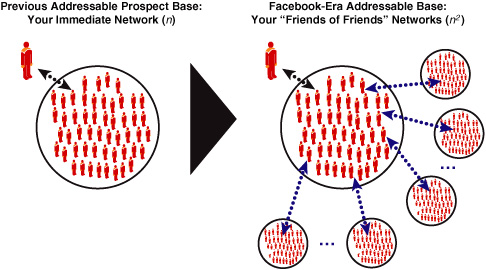
To reach even broader audiences than your extended networks, LinkedIn Open Networkers (LIONs) have emerged as an interesting phenomenon, generally for those in sales, business development, and recruiting. Traditional social network philosophy says that people should invite and accept connection requests with only people they personally know. This approach is both what I generally advocate and what I found in surveying my friends about their usage of Facebook and LinkedIn, as we talked about in the previous chapter. However, some LinkedIn members view this as overly restrictive and have adopted a policy of accepting connection invitations from strangers (see Figure 4.4). These individuals are mostly sales professionals who have chosen to sacrifice network quality for quantity.
Figure 4.4
Some estimates suggest that LinkedIn alone has hundreds of thousands of open networkers who will accept a connection with anyone.
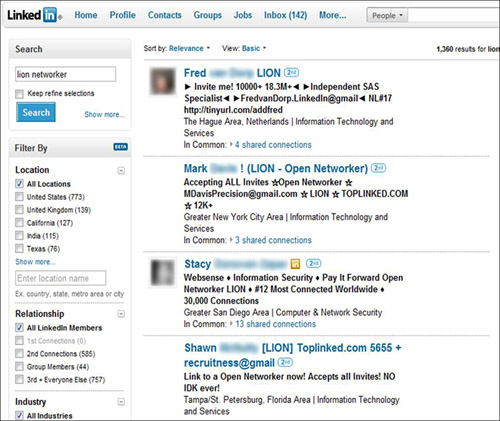
3. Making the First Call
Historically, most first calls don’t have a high success rate. Prospective customers dread them because they are usually irrelevant and, therefore, can feel insincere and like a waste of time. The salesperson dreads them because the recipient is annoyed by the call.
In the Facebook Era, the first call looks very different. Sales reps can perform more lead qualification and preparation beforehand, saving both their time and the prospect’s time. Sales reps can learn the answers to many traditional discovery questions by poking around the prospect’s social networking profile, such as his tenure at the company, key responsibilities and accomplishments, and past experience with solutions in your space, to name a few. Prospects are far more willing to take that first call if the pitch is tailored to their needs instead of just a generic push of every product and service. Data from the social networking sites enables sales reps to weed out prospects early. Or if they decide that the prospect might be a good fit, they can formulate the right introductory pitch and even involve mutual contacts who can serve as references. The basic expectation has become that salespeople have “done their homework” given the wealth of information available, and even the first call should reflect an initial level of effort.
The salespeople I interviewed said they are increasingly using LinkedIn for prospecting and making initial contact. They find that, surprisingly, the simplest emails solicit the most responses. Figure 4.5 shows a sample email one of my friends was kind enough to share. Tying back to the notion of bidirectional visibility, the sales rep in this example provides a link back to her own social networking profile so that the prospect can glean more information without sales pressure. The rep also calls out some commonality shared with the prospect (college alma mater, in this case) to differentiate herself and establish early rapport. Often profile data such as shared companies or industry experience, sports teams, hometowns, and fraternities and sororities are used to establish common ground and get one foot in the door. To prospects, the call feels less invasive because this is all information they have opted to share on public social networking sites, compared with the old model of marketing lists that might get bought or sold without their consent. This also ensures that the profile data and contact information reps are using are more accurate and up-to-date.
Figure 4.5
A sample sales prospecting email sent to a social network contact. It’s a good idea to keep initial contact short and simple and, if possible, find common ground to establish early interpersonal rapport.
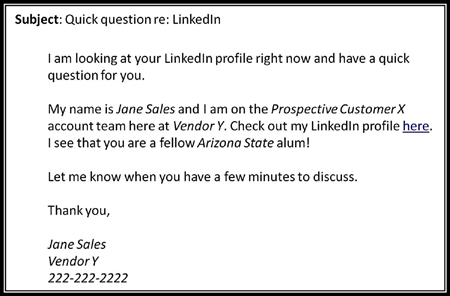
Another great benefit of social networking sites is the capability for sales reps to see who they know in common with the prospect. Instead of a cold call, reps might consider requesting a warm introduction from a mutual friend or business colleague. The warm intro increases the chances that the reps will rise above the spam and at least get to make their initial pitch. Before social networking sites, even if mutual contacts existed, it was hard to know that they were there.
As we briefly discussed in the last chapter, Facebook is a rudimentary form of CRM. I created Faceconnector (originally Faceforce) in fall 2007 to help reps connect the dots between the leads they were getting and the real people behind the leads. Traditional leads are a name, title, and company. People are far more complex and interesting. They are defined not just by their current title and employer, but also by the rich set of past experiences that have collectively shaped who they are, their interests, their hobbies, where they’re from, and who their friends are. People are getting more comfortable with sharing at least some of this information on their social networking profile. Faceconnector pulls real-time Facebook profile and friend information—such as schools attended, past employers, favorite books, interests, and friends in common—into Salesforce CRM so that reps viewing a lead or contact record inside Salesforce can see more than just the title and company (see Figure 4.6). They can begin to know the person and try to tailor a sales call that is more personal and relevant. They might even ask mutual friends for introductions.
Figure 4.6
Faceconnector (originally Faceforce) pulls real-time Facebook profile and social graph data into Salesforce CRM account, contact, and lead records so that sales reps can tap into the insights of the online social graph to make their pitch more personal and relevant.
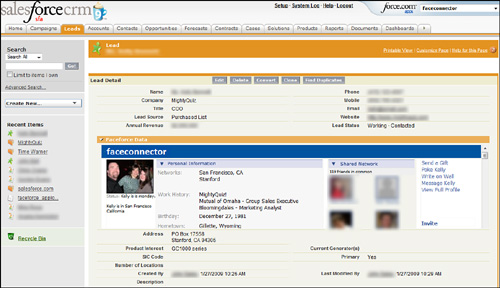
Of course, not every first call will result in a closed deal. The product might not be a good fit or the buyer might not have the necessary budget. Still, social and profile data from social networking sites can go a long way in increasing the first call success rate by enabling reps to qualify early, tailor their pitch, add a personal touch, and tap mutual contacts for references and introductions.
4. Navigating Complex Customer Organizations
In addition to helping facilitate one-on-one relationship building, you can use data from social networking sites at a high level for B2B deal strategy—that is, how to approach a deal, which individuals at the buyer you can connect with, and who has influence in the deal. Sales methodologies such as TAS, Miller–Heiman, and Solution Selling emphasize the importance of navigating customer organizations and identifying key decision makers. The online social graph contains powerful data to aid this exercise.
Online social networking sites reveal a wealth of information about people’s title and role, status in the company, working relationship with other contacts, and decision-making status. One high-tech account executive who has successfully sold into many IT departments told me that whenever he gets a new contact, he immediately goes to LinkedIn to understand how the individual fits into the bigger picture. He’s always on the lookout for a few subtle but critical pieces of information that greatly affect his strategy on a particular deal:
• Political strength and tenure—Almost always, people specify on their profiles how long they have been working at a company. If they are new, perhaps they have less political capital but more to prove, and therefore might be more open to bringing in a new vendor or way of doing things. You can usually also view their connections. Is the CIO connected to the CEO and CFO? Is she connected to her own IT directors? If not, this could be a sign that some internal politics might exist, and it could be a good opportunity to divide and conquer. On the other hand, if the CIO is seasoned and all her subordinates are new, that signals she might have greater say in the purchase decision. If many people in the company are connected and have publicly endorsed one another using LinkedIn recommendations, then it is likely a tight-knit organization that will require a different approach.
• Likelihood of being a champion or roadblock—Past experience, stated skills, and external connections provide valuable clues to whether someone could become a potential champion or roadblock to your deal. In this case, the account executive competes against Microsoft. He once came across a profile of an IT director at the prospective buyer that showed this person had extensive experience implementing Microsoft solutions, had been certified in several Microsoft technologies, and had many LinkedIn connections to Microsoft employees, resellers, and consultants. This raised a red flag in the rep’s mind, and, sure enough, this IT director became a big roadblock in the sale (which went through despite this). Similarly, someone who had been successfully using the account executive’s product at previous companies is likely to be a champion. Your prospects want to do the right thing for their companies, but often this is in the context of what is the right thing for their careers and where their skill sets and comfort zones lie.
• Organization structure—The account executive also told me he always searches on company name to get a list of the prospective buyer’s employees. Not only does this generate valuable contacts he might want to reach out to, but he can also glean information such as offices and subsidiaries, departments, titles, and how the company is organized. For example, the title of “vice president” might signal a powerful decision maker in one firm but be meaningless in another. One prospective buyer had 20 vice presidents out of 50 total employees! When you have a lay of the land, you can formulate the overall sales plan and start spending time winning over individual decision makers.
• Commonality with deal team members—Finally, this account executive recommends seeking commonalities not only between yourself and prospects, but also between other members of your account team and prospects. That way, you can strategically assign different people in your company to the various individuals at the prospective buyer to maximize rapport. For example, say a key technical executive at your prospect company is originally from Texas and graduated from Rice University. If you have a team of sales engineers and one happens to be a fellow Texan who also attended Rice, then that’s the person you want to assign to this prospect. As we talked about in the previous section, shared personal experiences, even if they are small coincidences, can go a long way in establishing rapport and differentiating your deal. This extends beyond individual reps to entire sales teams.
Building on the previous chapter’s discussion, social capital is the currency of influence in sales, too. Valuable information from social networking sites can arm reps with social capital for deals. Those with accurate maps of the social networks inside their prospective buyer know whom to talk to, are better known by others, know who gets along, and can use this knowledge to drive deal strategy and tactics.
5. Collaborating with Sales Team Members
Especially in B2B transactions, an entire sales team instead of one individual rep often works on a deal. In addition to the account executive, the team might include various product specialists, sales engineers, consultants, auditors, training staff, and others internal and external to the vendor company all working together to address a customer’s needs in the sales cycle and close the deal.
In addition to collaborating to assign the right account team members to the right prospect, sales teams can use online social networking to communicate, collaborate, and coordinate across their different functions and to log individual interactions with prospect stakeholders. According to the reps I interviewed, if team members are geographically dispersed, the personal connections facilitated by social networking sites can be invaluable for establishing rapport and coordinating group effort.
Another important use of enterprise social networking is for discovering expertise within the selling organization. Especially in large vendor companies with vast product portfolios and high employee turnover, it is often a challenge for account reps to find the right product experts internally to involve in the deal.
Not only can online social networking help reps collaborate within deals, but it can also aid collaboration across deals (see Figure 4.7). Sales Rep A might find herself in a deal that is very similar along certain dimensions—such as industry, customer size, product interest, or competitors—to another deal that Sales Rep B worked on six months ago. Perhaps Rep B found certain customer references, product demonstrations, and collateral especially useful in closing the deal. Rep A can be much more productive if she can leverage the combined experience and expertise of Rep B and all the other reps in her company instead of reinventing the wheel.
Of course, reps don’t—and shouldn’t—provide deal information on public social networking sites. Instead, this informal deal collaboration is happening within enterprise systems such as CRM, wikis, and intranet sites. Chapter 7, “Innovation and Collaboration in the Facebook Era,” discusses expertise discovery and internal collaboration in greater detail.
Figure 4.7
In addition to tapping social connections between sales reps and prospects, sales organizations can achieve greater productivity from collaborating within and across account teams. Internal social networking fosters collaborative coordination and collective wisdom.
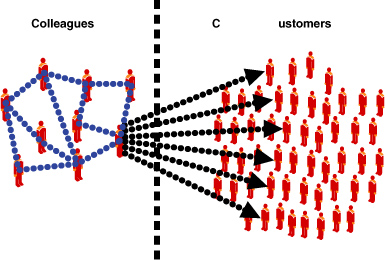
6. Providing Social Customer References
Customer references are critical for establishing trust to close deals. Testimonials from existing customers provide the most convincing social validation of your product. Those customers have voted with their money and time.
Traditionally, salespeople track down references in the prospective buyer’s region or industry to demonstrate competence serving the buyer’s unique requirements. But in today’s competitive environment, chances are good that other vendors have similar references. The online social graph provides valuable insight into who knows someone who can help set your references apart from the rest. Especially in situations in which you happen to be one of the lesser-known vendors, providing your prospect with references from their trusted friends and colleagues can be a powerful differentiator.
Why does this work? For any complex, noncommodity sale, an inherent degree of ambiguity exists in evaluating the product or service. Ultimately, differentiation means that a buyer is comparing apples to oranges and, at some point, needs to make a “leap-of-faith” decision in spite of the uncertainty. Customer references provide valuable information, both real and perceived, to mitigate this uncertainty. With social networking sites, it has become possible to take this further and find exactly which of your customers is connected with a prospective buyer. The following sidebar provides an example from medical sales.
The Power of Social References in Medical Sales
Rob is a top medical equipment sales rep, having achieved more than two times his sales quota each of the last five years. According to Rob, the biggest challenge in his job is getting and keeping doctors’ attention during sales meetings. Having been in different types of sales before his current role in medical sales, Rob says physicians are an especially tough audience because they are constantly distracted by crises and typically have patients waiting to see them following his sales call.
Rob’s secret to success? He relies on personal referrals from existing customers. He believes this has worked especially well for him because the medical community is a tight-knit group. People forge close friendships from medical school and residency, and develop professional contacts through conferences they are required periodically to attend.
These personal referrals used to happen on a one-off basis when an existing customer was willing to reach out to a friend. Social networking sites have made it more efficient for Rob to discover who knows whom. Instead of having to ask customers who they are willing to actively refer (often customers promise to make a referral and then forget), Rob goes on Facebook or LinkedIn to the prospect’s profile page and views their mutual contacts. Sometimes these include some of Rob’s existing customers. During sales meetings, Rob drops names. Rob says his prospects become instantly engaged, often recounting stories from medical school about the existing customer who is their friend. Rob’s sales-win rate and average deal size have gone way up as a result of this valuable information from social networking sites.
Although medical professionals as a group have been slower to adopt social networking, younger generations of doctors are joining Facebook en masse, and even more seasoned physicians are seeing the value in keeping in touch with people they meet at conferences.
As we discussed in Chapter 2, trust is transitive, to a degree. Because Rob’s customer trusts Rob (that’s why he’s a customer, after all) and Rob’s prospect trusts his friend who is Rob’s customer, Rob’s prospect is more willing to trust Rob. Reps such as Rob are tapping the social capital of relationships between their prospects and their existing customers to help close the deal (see Figure 4.8). From the prospective buyer’s perspective, she is getting a referral from a trusted colleague. This carries far more weight than an anonymous referral.
Figure 4.8
Customer references are more powerful when they come from someone the prospective buyer knows personally. Online social networking services enable sales reps to discover which of their existing customers might be connected to a prospective buyer.

7. Building and Sustaining Rapport
Because B2B sales cycles tend to take longer, reps often find themselves working multiple overlapping deals at once. As sales reps start new deals and shift focus from deal to deal, it is imperative they sustain rapport with prospects so that they can continue to make progress. Traditionally, this was difficult for most account executives to juggle.
Fortunately, Facebook can help. Casual interaction modes, such as Facebook pokes and messages, together with proactive updates in the form of News Feed alerts and Birthday Reminders (both described in Chapter 3, “How Relationships and Social Capital Are Changing”) on social networking sites, help reps save time staying in touch with their portfolio of customer and prospect contacts.
One account executive I interviewed swears by a combination of CRM calendar alerts and Facebook. For contacts at all his key accounts, he sets monthly reminders in his company’s CRM system to reach out and say hello. When a reminder pops up, he visits the person’s profile on Facebook to find something interesting and personal to say, sometimes completely unrelated to the deal. For example, last month the Facebook status message of a prospect CEO indicated she was en route to Tokyo. The account executive sent a (virtual) Facebook gift of sushi along with recommendations of his two favorite restaurants in Tokyo. (Figure 4.9 gives you an idea of what this might look like.)
Figure 4.9
Playful, casual interaction on Facebook is an easy way for reps to stay in touch and sustain rapport with contacts. For example, an account rep might respond to this prospect’s Facebook status message with a Facebook gift and Wall post.
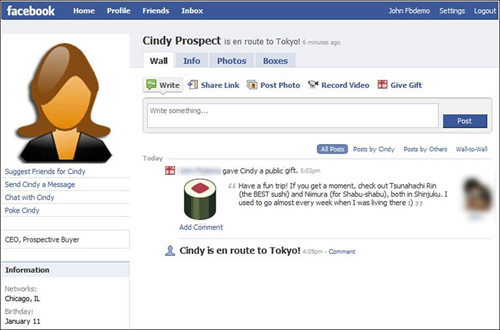
Periodic casual communication enabled by social networking sites can also help keep leads warm when the timing is not right for a prospect. Company reorganizations, budget cutbacks, and other competing projects are all-too-common reasons deals get put on the back burner. Instead of walking away completely, reps can use online social networking to stay engaged without expending a lot of their time. Updates from social networking sites provide the perfect excuse to check in on prospects and remind them in a friendly way that you still exist, without being so explicitly pushy about closing the sale.
Sales Reps Need to Be Versatile Networkers
As we discussed in Chapter 3, the notion that weak ties are generally more valuable for business than strong ties is an oversimplification in sales. Success in B2B sales, in particular, demands a more nuanced view of social networks. Tuba Östüner from Cass Business School and David Godes from Harvard Business School did an excellent job of distilling these nuances in their 2006 Harvard Business Review article “Better Sales Networks.”
We can gain new insights by revisiting the different stages in a typical sales cycle from the perspective of optimal network structures. The primary tasks required of a sales rep change, often significantly, at each stage in the sales cycle. The networks the sales rep utilizes to fulfill these tasks change, too. Different tasks require different kinds of networks:
• During sales prospecting, it holds true that entrepreneurial networks of weak ties are paramount for identifying and accessing opportunities. Therefore, LION networks are ideal during this initial stage.
• When it comes to winning buy-in across the prospect organization, the rep must focus on understanding the organizational map and who the key influencers are. As discussed earlier, a lot of this information can be gleaned from social networking sites, but ultimately, the rep needs to rely on one or a handful of internal customer champions. In terms of network structure, these relationships are characterized by clique networks of strong ties.
• Assembling the dream deal team is very much an exercise of internal networking at the rep’s company. The rep needs internal entrepreneurial networks of strong ties with colleagues and solution partners to identify, mobilize, and coordinate the right resources for the account.
• Finally, customer references require external entrepreneurial networks of strong ties not only between account executive and existing customers, but also between existing customers and prospects.
If information matters, then “hole-rich” (that is, with sparse contacts) entrepreneurial networks are ideal; if consistency and coordination matter, dense networks are ideal. Salespeople need both types of networks to close a deal. Generally, the importance of strong ties increases as we advance in the sales process.
Reps can adopt several different strategies to accommodate the need for multiple network structures. One option is to create multiple profiles. For example, a rep might have two LinkedIn profiles: One is a LION profile for prospecting; the other is a higher-quality exclusive profile for valuable customer and prospect contacts only. A second option is to use different systems for different networks. For instance, a rep might maintain a LION profile on LinkedIn for sales prospecting, use Facebook for personal relationships with high-value customer contacts, and leverage Microsoft Sharepoint for networking and sharing with coworkers. Finally, a rep could use advanced identity- and relationship-management tools, such as Facebook Friend Lists, to segment contacts within a social networking system and treat different connection types differently. (Chapter 10 talks about how to do this.)
The following guest expert sidebar from Gerhard Gschwandtner, founder and publisher of the popular magazine Selling Power, showcases a few more examples and best practices on how to improve the sales process with social networking sites.
Improving the Sales Process with Social Networking Sites
Gerhard Gschwandtner
Social networking is no longer a social phenomenon; it has become an integral part of a company’s sales and marketing strategy. A study released by Wetpaint and the Altimeter Group showed that companies with the highest level of social networking use for sales grew an average of 18% last year, and companies that used social networking the least declined by an average of 6%.
Consider these practical tips for improving the sales process with social networking techniques:
• Creating trust and rapport—Make it easy for your prospects to learn more about you on social networking sites. Action tip:On LinkedIn, you can drag and move the information categories on the left side to suit your needs. For example, if you are looking for a job, move your Experience and Education headings up front.
• Making the first call—Most salespeople try to schedule a call with their prospect. A sales manager of a software company recently came up with the idea to have the prospect make the first call to the salesperson. How? His team searches daily for tweets that contain their company name. Instead of connecting with the prospect directly, the manager set up a network of customers who are willing to tweet on the company’s behalf. Recently, the company noticed a question on Twitter from Starbucks about its service. The rep emailed his closest customer contact in the same city:Microsoft. The Microsoft executive tweeted back to the Starbucks executive. The next day, they had lunch. After lunch, the prospect called the software company salesperson.
• Navigating complex corporate organization structures—The larger the company, the greater the information challenge. Let’s say you want to sell to the head of research at IBM and you want to identify the top decision influencers. LinkedIn offers an advanced search capability that gives you access to IBM executives that work in eight research centers around the world. In this case, it is better to first visit the IBM Research Web site and click on People to find a list of program directors, scientists, and staff members by location. Then you can look up the contacts on LinkedIn.
Gerhard Gschwandtner (@SellingPowerMag) is the founder and publisher of Selling Power magazine.
Social CRM
Although many of the best salespeople are naturally instinctive relationship builders, certain sales methodologies have been proven in recent years to help the rest of us learn to emulate their success. Customer relationship management (CRM) attempts to capture the science of sales with software and processes to handle all of a company’s interactions with its customers. Sales force automation, in particular, builds in processes such as forecasting, territory management, email templates, dashboards, activity management, and deal alerts so that managers have visibility and sales teams can be more productive. Online social networking adds another dimension of power to CRM by enriching critical sales practices with contextual information and relationship-building tools.
In many ways, traditional CRM has been an important precursor to many of today’s social networking sites. At its most basic level, CRM is a fancy contact database. It is a one-way social networking tool that lets sales reps view “profiles” of their accounts, capture deal information, track performance, communicate with contacts, and share information internally with sales managers and other members of their account team.
The main difference with social networking sites such as LinkedIn and Facebook is that these offer bidirectional visibility and interaction. This transforms the sales dynamic into more of an even-sided partnership (see Table 4.1).
Table 4.1 Comparison of CRM and Modern Social Networking Site

Already, many of the innovations from the social Web are making their way into CRM systems, as evidenced by recent integrations between existing software vendors and Facebook, LinkedIn, and Twitter. Next-generation social CRM (SCRM) tools, such as what we’re building at Hearsay Labs, are incorporating even more Web 2.0–like interactions (see Figure 4.10). Other popular social CRM tools include Salesforce.com’s Service Cloud (more on this in Chapter 5, “Customer Service in the Facebook Era”), SAP CRM’s Twitter integration, and Microsoft Dynamics CRM “social networking accelerator” (see Figure 4.11). Oracle has a suite of social CRM applications too, but it’s important to note the “social” aspects here are more around internal sales team collaboration (similar to Salesforce Chatter) rather than integration with customer-facing functionality on Facebook and Twitter.
Figure 4.10
For many existing CRM applications, social integration is clearly an afterthought. We designed Hearsay 360 to incorporate the power and bidirectionality of Facebook, Twitter, and LinkedIn throughout the application experience.

By making the customer an active participant in CRM, SCRM helps companies not only benefit from more accurate data and better engagement, but also finally achieve a true 360-degree view of their customers across every touch point—whether it’s on the phone, on Facebook, presales, mid-deal, post-sales, or beyond.
In the following sidebar, well-known CRM expert, author, and consultant Paul Greenberg weighs in on social CRM and how it encompasses far more than just social media.
Figure 4.11
Microsoft Dynamics CRM recently introduced a social networking “accelerator” plug-in which pulls in social network status messages for contact records where a Twitter handle has been specified.

Social CRM Is Not Just Social Media
Paul Greenberg
A clear distinction exists between social CRM and social media. To understand the distinction, today’s customer is a social customer who is demanding engagement far more frequently than ever. It’s also a savvier customer—as Forrester Research revealed in 2009, more than 78% of all ages online are using social networks.
But this means a whole set of new requirements and tools for how a company will respond to the customer. I’m not saying to replace traditional customer relationship management:I’m saying extend it. One thing that remains the same regardless of this new customer is that businesses still have to run their operations, gather customer information, comply with government rules, and make sure that they capture and use data.
CRM becomes social CRM (SCRM) when businesses respond to the social customer’s ownership of the conversation that’s going on outside the businesses’control.
I don’t think I have to establish the increasing primacy of the customer activity going on in the social graph—that’s done wonderfully throughout the book. The “conversation prism” developed by Brian Solis (shown in Figure 4.12) highlights the incredible array of channel categories where customers are talking about you outside your control.
Figure 4.12
This is the “conversation prism,” a map of conversations on the Social Web developed by Brian Solis, founder and principal of FutureWorks. (You’ll hear from Solis in Chapter 6.)
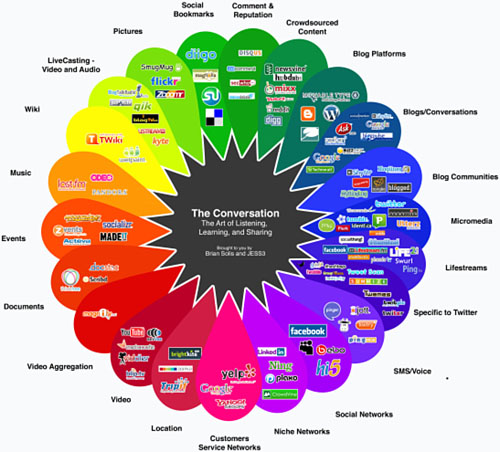
SCRM as a strategy defines the parameters that companies have to consider when it comes to engaging the customers they need to engage—not manage them. That means finding out and then considering what the customers require for that engagement—what products, services, tools, and experience they need.
SCRM finds the channels customers are communicating on, tracks the communications, identifies those customers communicating, and captures the information that the conversations are providing.
The industry has adopted a somewhat awkward but working definition of social CRM:
CRM is a philosophy and a business strategy, supported by a technology platform, business rules, workflow, processes, and social characteristics, designed to engage the customer in a collaborative conversation to provide mutually beneficial value in a trusted and transparent business environment. It’s the company’s response to the customer’s ownership of the conversation.
So much more than just social media, isn’t it?
Paul Greenberg (@pgreenbe) is the author of CRM at the Speed of Light: Essential Customer Strategies for the 21st Century (McGraw-Hill Osborne Media, 2009).
![]() The social Web is transformative in the sales process in two ways: First, reps can learn valuable information about customers and prospects. Second, social networking sites provide great opportunities for reps to engage in casual communications with and stay top of mind for customers.
The social Web is transformative in the sales process in two ways: First, reps can learn valuable information about customers and prospects. Second, social networking sites provide great opportunities for reps to engage in casual communications with and stay top of mind for customers.
![]() Facebook is valuable even in B2B sales because, ultimately, it is an individual or group of individuals who make the purchase decision. Facebook can help sales reps build better relationships with individuals, such as getting to know them on a personal level.
Facebook is valuable even in B2B sales because, ultimately, it is an individual or group of individuals who make the purchase decision. Facebook can help sales reps build better relationships with individuals, such as getting to know them on a personal level.
![]() Sales reps can build trust and credibility by conveying experience and qualifications through their social network profiles. The personal branding discussion from the previous chapter applies especially to outward-facing professionals such as sales.
Sales reps can build trust and credibility by conveying experience and qualifications through their social network profiles. The personal branding discussion from the previous chapter applies especially to outward-facing professionals such as sales.
![]() In the Facebook Era, much of the lead qualification process occurs before reps ever reach out to the prospect by using the information available on public social networking sites.
In the Facebook Era, much of the lead qualification process occurs before reps ever reach out to the prospect by using the information available on public social networking sites.
![]() In addition to explicit data such as role and company name, savvy reps can infer additional important information about prospect organizations from social networking sites, such as political strength and tenure, the likelihood of an individual to be a champion or a roadblock in your sales cycle, and organizational structure.
In addition to explicit data such as role and company name, savvy reps can infer additional important information about prospect organizations from social networking sites, such as political strength and tenure, the likelihood of an individual to be a champion or a roadblock in your sales cycle, and organizational structure.
![]() Explore using advanced search on LinkedIn, Facebook, and Twitter to prospect for potential customers.
Explore using advanced search on LinkedIn, Facebook, and Twitter to prospect for potential customers.
![]() Before you make the first call, check out your prospect’s profile information and see if you have any common ground (such as your hometown or favorite baseball team) that you can use to start casual conversation, when appropriate.
Before you make the first call, check out your prospect’s profile information and see if you have any common ground (such as your hometown or favorite baseball team) that you can use to start casual conversation, when appropriate.
![]() Use Facebook and Twitter to keep in touch with prospects and customers. Comment on and “like” their status messages, and wish them a happy birthday when it’s their birthday. Do this only with prospects whom you feel would be receptive to this. (This is largely dependent on age.) Otherwise, it can be creepy.
Use Facebook and Twitter to keep in touch with prospects and customers. Comment on and “like” their status messages, and wish them a happy birthday when it’s their birthday. Do this only with prospects whom you feel would be receptive to this. (This is largely dependent on age.) Otherwise, it can be creepy.
![]() Make your next customer reference a “social customer reference”— that is, try to find an existing customer whom your prospect already knows and trusts.
Make your next customer reference a “social customer reference”— that is, try to find an existing customer whom your prospect already knows and trusts.
![]() Per CRM expert Paul Greenberg’s advice, integrate your social media strategy and CRM strategy. They go hand-in-hand. To stay competitive and to succeed, today’s CRM must be social.
Per CRM expert Paul Greenberg’s advice, integrate your social media strategy and CRM strategy. They go hand-in-hand. To stay competitive and to succeed, today’s CRM must be social.
